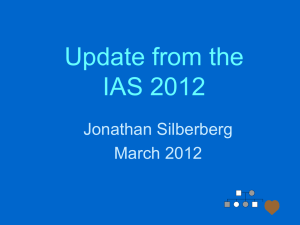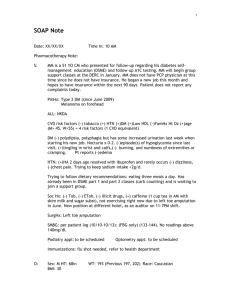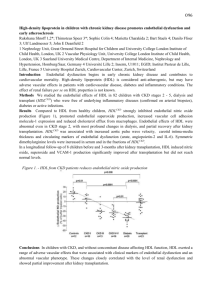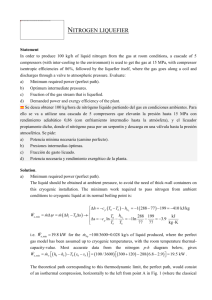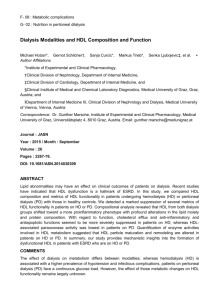Digital Systems Modeling and Synthesis
advertisement
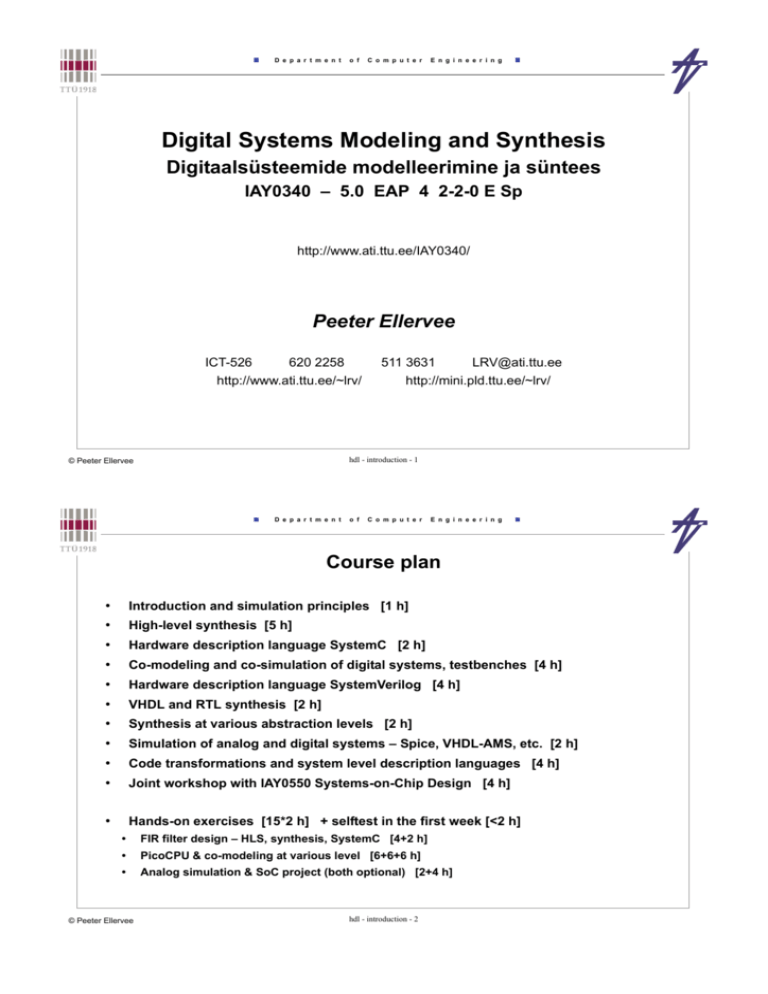
D e p a r t m e n t o f C o m p u t e r E n g i n e e r i n g Digital Systems Modeling and Synthesis Digitaalsüsteemide modelleerimine ja süntees IAY0340 – 5.0 EAP 4 2-2-0 E Sp http://www.ati.ttu.ee/IAY0340/ Peeter Ellervee ICT-526 620 2258 511 3631 http://www.ati.ttu.ee/~lrv/ LRV@ati.ttu.ee http://mini.pld.ttu.ee/~lrv/ hdl - introduction - 1 © Peeter Ellervee D e p a r t m e n t o f C o m p u t e r E n g i n e e r i n g Course plan • • • • • • • • • • Introduction and simulation principles [1 h] • Hands-on exercises [15*2 h] + selftest in the first week [<2 h] High-level synthesis [5 h] Hardware description language SystemC [2 h] Co-modeling and co-simulation of digital systems, testbenches [4 h] Hardware description language SystemVerilog [4 h] VHDL and RTL synthesis [2 h] Synthesis at various abstraction levels [2 h] Simulation of analog and digital systems – Spice, VHDL-AMS, etc. [2 h] Code transformations and system level description languages [4 h] Joint workshop with IAY0550 Systems-on-Chip Design [4 h] • FIR filter design – HLS, synthesis, SystemC [4+2 h] • PicoCPU & co-modeling at various level [6+6+6 h] • Analog simulation & SoC project (both optional) [2+4 h] © Peeter Ellervee hdl - introduction - 2 D e p a r t m e n t o f C o m p u t e r E n g i n e e r i n g Textbooks • • • • • Dirk Jansen et al. (editors), “The electronic design automation handbook.” [2003] Peter J. Ashenden, “The Designer's Guide to VHDL.” [2008] Volnei A. Pedroni, “Circuit Design with VHDL.” [2004] Stuart Sutherland, Simon Davidman, Peter Flake, “System Verilog for Design.” [2010] Michael John Sebastian Smith, “Application-Specific Integrated Circuits.” [1997] • • http://www10.edacafe.com/book/ASIC/ASICs.php David C. Black, Jack Donovan, “SystemC: From the Ground Up.” [2004] • Plus some good older ones • Kalle Tammemäe, “Riistvara kirjeldamiskeel VHDL.” [2002] • K.C. Chang, “Digital systems design with VHDL and synthesis: an integrated approach.” [1999] • Ken Coffman, “Real world FPGA design with Verilog.” [2000] • Plus web-based source, incl. WikipediA • Bryan Mealy, Fabrizio Tappero, “Free Range VHDL.” [2012] – http://freerangefactory.org hdl - introduction - 3 © Peeter Ellervee D e p a r t m e n t o f C o m p u t e r E n g i n e e r i n g Motivation • Multi and many core systems on chip (SoC, NoC, etc.) require new design methodologies • • to increase designers productivity to get products faster into market • There exists a demand for efficient design methodologies at higher abstraction levels • A different thinking needed from the designers • At higher abstraction levels • • a designer has much wider selection of possible decisions each of these decisions has also a stronger impact onto the quality of the final design © Peeter Ellervee hdl - introduction - 4 D e p a r t m e n t o f C o m p u t e r E n g i n e e r i n g Optimizations • Optimizations at logic level • • thousands of nodes (gates) can exist • optimization algorithms can take into account only few of the neighbors • only few possible ways exist how to map an abstract gate onto physical gate from target library Optimizations at register transfer level (RTL) • • • hundreds of nodes exist (adders, registers, etc.) there are tens of possibilities how to implement a single module At higher levels, e.g. at system level • • • there are only tens of nodes to handle (to optimize) there may exist hundreds of ways how to implement a single node every possible decision affects much stronger the constraints put onto neighboring nodes thus significantly affecting the quality of the whole design hdl - introduction - 5 © Peeter Ellervee D e p a r t m e n t o f C o m p u t e r E n g i n e e r i n g Decisions at higher abstraction levels • Two major groups of decisions • selection of the right algorithm to solve a subtask • making transformations inside the algorithm, e.g. parallel versus sequential execution • affect primarily the final architecture of the chip • decisions about the data representation • e.g. floating point versus fixed point arithmetic, bit-width, precision. • Selection of a certain algorithm puts additional constraints also onto the data representation • Selecting a data representation narrows also the number of algorithms available © Peeter Ellervee hdl - introduction - 6 D e p a r t m e n t o f C o m p u t e r E n g i n e e r i n g Design steps • System design a.k.a. Architectural-level synthesis a.k.a. High-level synthesis a.k.a. Structural synthesis • • • description / specification –> block diagram determining the macroscopic structure, i.e., interconnection of the main modules (blocks) and their functionality Logic design • • • block diagram –> logic gates determining the microscopic structure, i.e., interconnection of logic gates Physical design a.k.a. Geometrical-level synthesis • logic gates –> transistors, wires hdl - introduction - 7 © Peeter Ellervee D e p a r t m e n t o f C o m p u t e r E n g i n e e r i n g Abstraction levels • message: header1 & payload1 | header2 & payload2 | header3 & payload1 | illegal System level • • • 0F modules / methods AB 34 0234 2FE4 channels / protocols System Level Synthesis • Clustering. Communication synthesis. . . . message=receive(channel_1); add(list,message); sort(list); send(first(list,REMOVE),channel_2); . . . © Peeter Ellervee hdl - introduction - 8 14DA D e p a r t m e n t o f C o m p u t e r Abstraction levels • E n g i n e e r i n g message: 0001 & xxxxxxxxxxxx | 0010 & yyyyyyyyyyyy | 0101 & xxxxxxxxxxxx | ---------------- Algorithmic level • • • 0F (sub)modules / algorithms AB 0234 34 2FE4 14DA buses / protocols High-Level Synthesis • Resource or time constrained scheduling. • Resource allocation. Binding. . . . message=blocking_receive(channel_1); append(list,message); bubble_sort(list); msg_pnt=first(list); message= *msg_pnt; nonblocking_send(message,channel_2); remove(list,msg_pnt); . . . hdl - introduction - 9 © Peeter Ellervee D e p a r t m e n t o f C o m p u t e r E n g i n e e r i n g Abstraction levels • Register transfer (RT) level • • • + blocks / logic expressions > buses / words Level Synthesis • • & Data-path synthesis. Controller synthesis. Logic level • • • logic gates / logic expressions nets / bits Logic Level Synthesis • Logic minimization. Optimization, overhead removal. © Peeter Ellervee hdl - introduction - 10 D e p a r t m e n t o f C o m p u t e r E n g i n e e r i n g Abstraction levels • Physical level • transistors / wires • polygons • Physical Level Synthesis • Library mapping. Placement. Routing. hdl - introduction - 11 © Peeter Ellervee D e p a r t m e n t o f C o m p u t e r Design flow • E n g i n e e r i n g HW design flow Specification refinement • • • from higher to lower abstraction levels refinement = transformations Algorithm selection • • • Algorithmic level universal vs. specific speed vs. memory consumption RT level Partitioning • • • System level introducing structure implementation environment – HW vs. SW Logic level Technology mapping • • converting algorithm into Boolean equations replacing Boolean equations with gates © Peeter Ellervee hdl - introduction - 12 Physical level D e p a r t m e n t o f C o m p u t e r E n g i n e e r i n g Y-chart System level Algorithmic level Behavioural Domain Structural Domain Register transfer level System Specification CPU, Memory Logic level Algorithm Processor, Sub-system Register-transfer specification ALU, Register, MUX Circuit level Boolean Equation Gate, Flip-flop Transistor Differential Equation Rectangle / Polygon-Group Standard-Cell / Sub-cell Macro-cell Block / Chip Chip / Board Physical Domain hdl - introduction - 13 © Peeter Ellervee D e p a r t m e n t o f C o m p u t e r E n g i n e e r i n g Y-transformations Synthesis Analysis Behavioural Domain Re fin em ent Ab stra ctio n Generation Structural Domain Optimization Extraction Physical Domain (Geometrical Domain) © Peeter Ellervee hdl - introduction - 14 D e p a r t m e n t o f C o m p u t e r E n g i n e e r i n g Synthesis – design automation transistors per chip technological capability designer’s productivity today time hdl - introduction - 15 © Peeter Ellervee D e p a r t m e n t o f C o m p u t e r E n g i n e e r i n g Design automation – a bit idealistic view • 1990 – 4 Kgates / year / designer • 1993 – inhouse place and route – 5.6K • 1995 – engineer (RTL–>GDSII) – 9.1K • 1997 – small blocks reuse (2.5K-75K) – 40K • 1999 – large blocks reuse (75K-1M) – 56K • 2001 – synthesis (RTL–>GDSII) – 91K • 2003 – intelligent testbench – 125K • 2005 – behavioral and architectural levels, HW/SW (co)design – 200K • 2007 – very large blocks reuse (>1M, IP cores) – 600K • 2009 – homogeneous parallel processing (multi-core) – 1200K • Future – hw/sw co-verification, executable specification, etc. © Peeter Ellervee hdl - introduction - 16 D e p a r t m e n t o f C o m p u t e r E n g i n e e r i n g Market = $$$ • Design cost • • design time & chips production cost • huge investments (G$) • almost impossible to correct High cost of modifications • • large production volumes are more cost effective • zero-defect is very important • following market trends is important Price is inversely proportional to production volume • • common purpose processors - cheap but not always usable • ASIC - application specific tuning (e.g. telecommunication) • prototypes - flexibility is extremely important in the development phase • special purpose chips (e.g. satellites) Reconfigurability • flexible products, possibility to modify working circuits hdl - introduction - 17 © Peeter Ellervee D e p a r t m e n t o f C o m p u t e r E n g i n e e r i n g Design criteria • Three dimensions - area, delay, power • • • size, speed, energy consumption four dimensions - plus testability (reliability) Area • • gates, wires, buses, etc. Delay • • inside a module, between modules, etc. Power consumption • • average, peak and total Optimizations • • transferring from one dimension to another design quality is measured by combined parameters, e.g., energy consumption per input sample © Peeter Ellervee hdl - introduction - 18 D e p a r t m e n t o f C o m p u t e r E n g i n e e r i n g HDL – designing Systems-on-Chip (SoC) & Networks-on-Chip (NoC) Idea Language Technology !!! TTL VHDL Verilog Matlab CMOS GaAs whatever • Fully automated flow from specification to implementation? • analysis, modeling, iterations etc. needed... hdl - introduction - 19 © Peeter Ellervee D e p a r t m e n t o f C o m p u t e r MYTH #1 • High level design is a single pass • Iterations needed • • Functionality Design goals © Peeter Ellervee hdl - introduction - 20 E n g i n e e r i n g Chip D e p a r t m e n t o f C o m p u t e r E n g i n e e r i n g MYTH #2 • Top down design, in its purest form, works Prove system function Prove critical performance in specific technology • The pure breadth-first approach never actually works in practice • • • Bottom-up technology information must be considered early and often Go depth-first for critical parts Mix breadth-first with depth-first hdl - introduction - 21 © Peeter Ellervee D e p a r t m e n t o f C o m p u t e r E n g i n e e r i n g MYTH #3 • You don’t need to understand digital design anymore • One must know hardware to get a good hardware • Hope • • Intimate knowledge of hardware is not necessary to design digital systems Fear • • Using HDL based design methodology will turn them into software hackers Reality • • • High performance designs require a good deal of understanding about hardware Designers must seed the synthesis tools with good starting points Understanding the synthesis process is necessary to get good quality designs © Peeter Ellervee hdl - introduction - 22 D e p a r t m e n t o f C o m p u t e r E n g i n e e r i n g MYTH #4 • Designer’s job is just the functional specification now • Specification = Functionality + Design goals + Operating conditions • Schematic capture • • • Design goals and operating conditions were implicit (in designer’s mind) Implementation was chosen (modified) to meet goals and conditions HDL • • Design goals (area, speed, power, etc.) are explicitly specified Operating conditions (variations, loads, drives) are also explicitly specified hdl - introduction - 23 © Peeter Ellervee D e p a r t m e n t o f C o m p u t e r E n g i n e e r i n g MYTH #5 • Behavioral level is better than RTL • Behavioral (a.k.a. algorithmic, high) level synthesis is not as mature as RTL (register-transfer level) • If your specification includes enough timing information use RTL synthesis • Behavioral constructs like while, if-then-else does not necessarily mean behavioral specification • ... and/or can be misinterpreted © Peeter Ellervee hdl - introduction - 24 D e p a r t m e n t o f C o m p u t e r E n g i n e e r i n g Design process today • Hardware Description Language --- Highway is green, sidestreet is red. -if sidestreet_car = NoCar then wait until sidestreet_car = Car; end if; -- Waiting for no more than 25 seconds ... if highway_car = Car then wait until highway_car = NoCar for 25 sec; end if; -- ... and changing lights highway_light <= GreenBlink; wait for 3 sec; highway_light <= Yellow; sidestreet_light <= Yellow; wait for 2 sec; highway_light <= Red; sidestreet_light <= Green; hdl - introduction - 25 © Peeter Ellervee D e p a r t m e n t o f C o m p u t e r E n g i n e e r i n g Prototyping • Possibility to check how a system works at conditions very close to the operating environment without the need to create expensive chips XESS Corp., www.xess.com, $400 [ Xilinx Inc., FPGA XC3S1000 ] © Peeter Ellervee ErST Electronics, www.erst.ch, 2340€ [ Xilinx Inc., FPGA X2V2000 ] hdl - introduction - 26 D e p a r t m e n t o f C o m p u t e r E n g i n e e r i n g Chip - the final result hdl - introduction - 27 © Peeter Ellervee D e p a r t m e n t o f C o m p u t e r E n g i n e e r i n g Reality • Found On First Spin ICs/ASICs • Functional Logic Error - 43% • Analog Tuning Issue - 20% • Signal Integrity Issue - 17% • Clock Scheme Error - 14% • Reliability Issue - 12% • Mixed Signal Problem - 11% • Uses Too Much Power - 11% • Has Path(s) Too Slow - 10% • Has Path(s) Too Fast - 10% • IR Drop Issues - 7% • Firmware Error - 4% • Other Problem - 3% • Overall 61% of New ICs/ASICs Require At Least One Re-Spin. • © Peeter Ellervee Aart de Geus, Chairman & CEO of Synopsys, Boston SNUG keynote address, 9.09.2003 hdl - introduction - 28 D e p a r t m e n t o f C o m p u t e r E n g i n e e r i n g Trends 2000 2010 2020 memory size 2 Gbit 256 Gbit 1024 Gbit transistors per cm2 8106 160106 480106 internal clock frequency 1.5 GHz 10 GHz 40 GHz external / bus clock frequency 0.5 GHz 1.5 GHz 2.5 GHz pin count 2000 6000 10000 chip area 800 mm2 1300 mm2 1800 mm2 wire width 140 nm 40 nm 10 nm supply voltage 1.5 V 0.8 V 0.5 V power consumption 100 W 170 W 300 W power consumption (batteries) 0.5 W 1.5 W 2.5 W NB! These are rough estimates only! hdl - introduction - 29 © Peeter Ellervee D e p a r t m e n t o f C o m p u t e r E n g i n e e r i n g Problems physical level quantum effects noise logic level crosstalk speed of light system level • • • # of transistors GALS – globally asynchronous locally synchronous mixed signal – digital and analog circuits on the same chip Modeling is getting more and more important... © Peeter Ellervee hdl - introduction - 30 10 mm –> (108 m/s) –> 10-10 s –> (10%) –> 1 GHz !? D e p a r t m e n t o f C o m p u t e r E n g i n e e r i n g Simulation • Simulation = modeling + analysis pattern generator • Logic level simulation • RT-level simulation • Functional level simulation • • =? Behavioral level simulation simulator stimuli circuit model results edit entity test is end test; architecture hello of test is begin process begin assert false report ”Hello world!” severity note; wait; end process; end hello; Test environment == stimuli generator + DUT + results analyzer • logic analyzer Modeling System level simulation • DUT simul rdy ack val1 val2 testbench NB! Detailed simulation is slow! hdl - introduction - 31 © Peeter Ellervee D e p a r t m e n t o f C o m p u t e r E n g i n e e r i n g Use of HDL –> Simulation • Simulation = modeling + analysis • Logic / register-transfer / functional (behavioral) / system level simulation concurrent / parallel modules module / unit / process connected via signal / channels continuous execution is slow sequential vs. concurrent execution? only when needed? execution order?! time / event triggered current / new values to avoid non-determinism different simulation engines event queue history+future © Peeter Ellervee hdl - introduction - 32 D e p a r t m e n t o f C o m p u t e r E n g i n e e r i n g Simulators & timing/delay models • Time & events • Time-driven: all components of the digital logic system are evaluated at every time step • Event-driven: system input events are kept in an time-ordered event queue • Delay models • • • • unit-delay (RTL simulator) zero-delay (Verilog) delta-delay (VHDL) – -delay, -delay Simulation engines • all make use of the three following steps but details differ... • (1) calculate (and remember) new values for signals • (2) update signal values • (3) update time hdl - introduction - 33 © Peeter Ellervee D e p a r t m e n t o f C o m p u t e r E n g i n e e r i n g Unit-delay simulation model Begin simulation cycle Evaluate expressions and add events (future values) to the buffers Update values for the next cycle Finish simulation cycle T © Peeter Ellervee NO Has the halting condition been met? hdl - introduction - 34 YES Nothing left to do D e p a r t m e n t o f C o m p u t e r E n g i n e e r i n g Unit-delay simulation model (example) x1 <= a and b; x2 <= not c; y <= x1 xor x2; a b c x1 a b c x1 x2 y y t x2 event queues t+1ns b=1 x1=1 c=0 x2=1 t+2ns time [ns] y=0 hdl - introduction - 35 © Peeter Ellervee D e p a r t m e n t o f C o m p u t e r E n g i n e e r i n g Zero-delay simulation model (Verilog) Begin simulation cycle Immediately evaluate and update Add new event to the queue YES Are there more events scheduled for this moment? NO Finish simulation cycle T © Peeter Ellervee NO Has the halting condition been met? hdl - introduction - 36 YES Nothing left to do D e p a r t m e n t o f C o m p u t e r E n g i n e e r i n g Zero-delay simulation model (example #1) x1 <= a and b; x2 <= not c; y <= x1 xor x2; a b c x1 a b c x1 x2 y y t t t t x2 event queues b=1 b=1 c=0 x1=1 c=0 c=0 x1=1 x2=1 x1=1 x2=1 y=0 t time x2=1 [ns] y=0 hdl - introduction - 37 © Peeter Ellervee D e p a r t m e n t o f C o m p u t e r E n g i n e e r i n g Zero-delay simulation model (example #2) x1 <= a and b; x2 <= not c; y <= x1 xor x2; a b c x1 a b c x1 x2 y y t t t x2 event queues © Peeter Ellervee t b=1 b=1 x1=1 y=1 c=0 x1=1 y=1 c=0 c=0 c=0 x2=1 hdl - introduction - 38 t time x2=1 [ns] y=0 D e p a r t m e n t o f C o m p u t e r E n g i n e e r i n g Delta-delay (VHDL) simulation model Initialization. All processes are resumables Begin simulation cycle Resume processes Evaluate and assign variables. Evaluate signal assignments and add results to the signal drivers. Wait until processes are suspended. Update signal values Evaluate wait conditions and add resumable processes to a queue Are there events to be processed? NO T YES Are they at time “now”? Next event before time’high? Nothing left to do NO Finish simulation cycle hdl - introduction - 39 © Peeter Ellervee D e p a r t m e n t o f C o m p u t e r E n g i n e e r i n g Delta-delay (VHDL) simulation model (example) x1 <= a and b; x2 <= not c; y <= x1 xor x2; a b c x1 a b c x1 x2 y y t t+2 x2 event queues © Peeter Ellervee t+ b=1 x1=1 c=0 x2=1 hdl - introduction - 40 y=0 time [ns]


